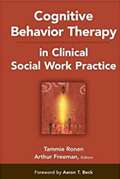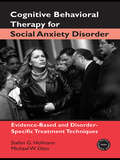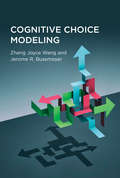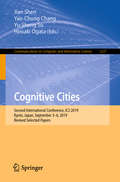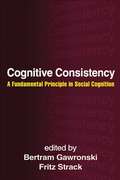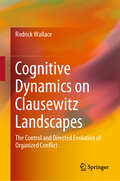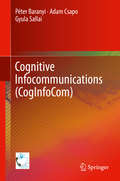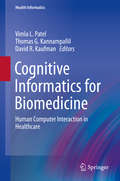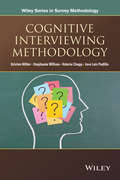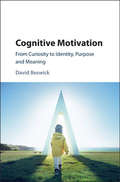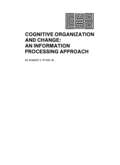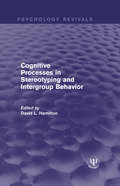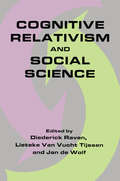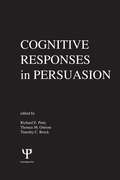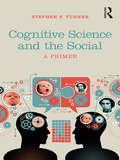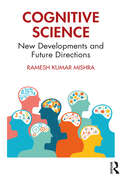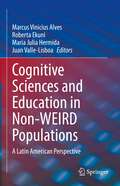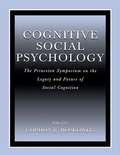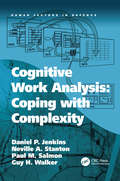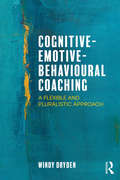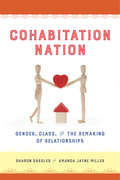- Table View
- List View
Cognitive Behavior Therapy in Clinical Social Work Practice (Springer Series on Social Work)
by Arthur Freeman Tammie RonenEdited by a leading social work authority and a master CBT clinician, this first-of-its-kind handbook provides the foundations and training that social workers need to master cognitive behavior therapy. <p><p> From traditional techniques to new techniques such as mindfulness meditation and the use of DBT, the contributors ensure a thorough and up-to-date presentation of CBT. Covered are the most common disorders encountered when working with adults, children, families, and couples including: <p> Anxiety disorders <p>Depression <p>Personality disorder <p>Sexual and physical abuse <p>Substance misuse <p>Grief and bereavement <p>Eating disorders <p><p>Written by social workers for social workers, this new focus on the foundations and applications of cognitive behavior therapy will help individuals, families, and groups lead happier, fulfilled, and more productive lives.
Cognitive Behavioral Therapy for Social Anxiety Disorder: Evidence-Based and Disorder-Specific Treatment Techniques (Practical Clinical Guidebooks)
by Stefan G. Hofmann Michael W. OttoSocial phobia, or social anxiety disorder, is among the most common (and debilitating) of the anxiety disorders, and at any given time it effects somewhere between 3 and 5% of the US population, with similar statistics found in countries around the world. Cognitive-Behavioral Therapy (CBT) has been demonstrated to be the most effective form of treatment for social phobia, but research has shown that conventional CBT principles and general interventions fall short of the mark. With this in mind, Hofmann and Otto have composed an organized treatment approach that includes specifically designed interventions to strengthen the relevant CBT strategies. This volume builds upon empirical research to address the psychopathology and heterogeneity of social phobia, creating a series of specific interventions with numerous case examples.
Cognitive Choice Modeling
by Jerome R. Busemeyer Zheng Joyce WangThe emerging interdisciplinary field of cognitive choice models integrates theory and recent research findings from both decision process and choice behavior.Cognitive decision processes provide the interface between the environment and brain, enabling choice behavior, and the basic cognitive mechanisms underlying decision processes are fundamental to all fields of human activity. Yet cognitive processes and choice processes are often studied separately, whether by decision theorists, consumer researchers, or social scientists. In Cognitive Choice Modeling, Zheng Joyce Wang and Jerome R. Busemeyer introduce a new cognitive modeling approach to the study of human choice behavior. Integrating recent research findings from both cognitive science and choice behavior, they lay the groundwork for the emerging interdisciplinary field of cognitive choice modeling.
Cognitive Cities: Second International Conference, IC3 2019, Kyoto, Japan, September 3–6, 2019, Revised Selected Papers (Communications in Computer and Information Science #1227)
by Hiroaki Ogata Jian Shen Yao-Chung Chang Yu-Sheng SuThis book constitutes refereed proceeding of the Second International Cognitive Cities Conference, IC3 2019, held in Kyoto, Japan, in September 2019. The 37 full papers and 46 short papers were thoroughly reviewed and selected from 206 submissions. The papers are organized according to the topical sections on cognitive city for special needs; cognitive city theory, modeling and simulation; XR and educational innovations for cognitive city; educational technology and strategy in cognitive city; safety, security and privacy in cognitive city; artificial intelligence theory and technology related to cognitive city; Internet of Things for cognitive city; business application and management for cognitive city; big data for cognitive city; engineering technology and applied science for cognitive city; maker, CT and STEAM education for cognitive city.
Cognitive Consistency
by Bertram GawronskiThis volume provides an overview of recent research on the nature, causes, and consequences of cognitive consistency. In 21 chapters, leading scholars address the pivotal role of consistency principles at various levels of social information processing, ranging from micro-level to macro-level processes. The book's scope encompasses mental representation, processing fluency and motivational fit, implicit social cognition, thinking and reasoning, decision making and choice, and interpersonal processes. Key findings, emerging themes, and current directions in the field are explored, and important questions for future research identified.
Cognitive Dynamics on Clausewitz Landscapes: The Control and Directed Evolution of Organized Conflict
by Rodrick WallaceThis book applies cutting-edge methods from cognitive and evolutionary theories to develop models of conflict between hierarchically-structured cognitive entities under circumstances of imprecision, uncertainty and stress. Characterized as friction and the fog-of-war by the Prussian military theorist Carl von Clausewitz, such conditions impair institutional cognition in real-time conflict and pose a real and continuing threat to organizations, such as the US military. In a linked collection of formal essays and a mathematical appendix, the book explores different aspects of cognitive and evolutionary process as conducted under the direction of doctrine that acts as a kind of genome for retention of what is learned through Lamarckian evolutionary selection pressures: armies and corporate entities learn from conflict, and incorporate that learning into their ongoing procedures. The book proposes models and policy solutions for strategic competence. A central feature of the book is a formal description of the famous OODA loop of the US military theorist John Boyd in terms of the Data Rate Theorem that links control and information theories. That description is expanded to cover more fully the impact of stochastic fog-of-war effects on tactical and operational scales of conflict. Subsequent chapters examine in more detail the role of doctrine, and the particular effect of embedding culture on cognitive and Lamarckian evolutionary processes associated with conflict on tactical, operational, and strategic scales and levels of organization. A scientifically sophisticated exercise in applied mathematics, history, evolutionary theory, and ecosystem theory, this book will be appropriate for researchers and students interested in defense, security, and international relations, as well as non-academic career professionals in government and industry.
Cognitive Infocommunications (CogInfoCom)
by Péter Baranyi Adam Csapo Gyula SallaiThis book describes the theoretical foundations of cognitive infocommunications (CogInfoCom), and provides a survey on state-of-the-art solutions and applications within the field. The book covers aspects of cognitive infocommunications in research fields such as affective computing, BCI, future internet, HCI, HRI, sensory substitution, and virtual/augmented interactions, and also introduces newly proposed paradigms and initiatives under the field, including CogInfoCom channels, speechability and socio-cognitive ICT. The book focuses on describing the merging between humans and information and communications technology (ICT) at the level of cognitive capabilities with an approach towards developing future cognitive ICT.
Cognitive Informatics for Biomedicine: Human Computer Interaction in Healthcare (Health Informatics)
by Vimla L. Patel Thomas G. Kannampallil David R. KaufmanThe book reports on the current state on HCI in biomedicine and health care, focusing on the role of human factors, patient safety well as methodological underpinnings of HCI theories and its application for biomedical informatics. Theories, models and frameworks for human-computer interaction (HCI) have been recognized as key contributors for the design, development and use of computer-based systems. In the clinical domain, key themes that litter the research landscape of health information technology (HIT) are usability, decision support and clinical workflow - all of which are affected directly or indirectly by the nature of HCI. While the implications of HCI principles for the design of HIT are acknowledged, the adoption of the tools and techniques among clinicians, informatics researchers and developers of HIT are limited. There is a general consensus that HIT has not realized its potential as a tool to facilitate clinical decision-making, the coordination of care and improves patient safety. Embracing sound principles of iterative design can yield significant dividends. It can also enhance practitioner's abilities to meet "meaningful use" requirements. The purpose of the book is two-fold: to address key gaps on the applicability of theories, models and evaluation frameworks of HCI and human factors for research in biomedical informatics. It highlights the state of the art, drawing from the current research in HCI. Second, it also serves as a graduate level textbook highlighting key topics in HCI relevant for biomedical informatics, computer science and social science students working in the healthcare domain. For instructional purposes, the book provides additional information and a set of questions for interactive class discussion for each section. The purpose of these questions is to encourage students to apply the learned concepts to real world healthcare problems.
Cognitive Interviewing Methodology
by Kristen Miller Jose Luis Padilla Stephanie Willson Valerie CheppAN INTERDISCIPLINARY PERSPECTIVE TO THE EVOLUTION OF THEORY AND METHODOLOGY WITHIN COGNITIVE INTERVIEW PROCESSESProviding a comprehensive approach to cognitive interviewing in the field of survey methodology, Cognitive Interviewing Methodology delivers a clear guide that draws upon modern, cutting-edge research from a variety of fields.Each chapter begins by summarizing the prevailing paradigms that currently dominate the field of cognitive interviewing. Then underlying theoretical foundations are presented, which supplies readers with the necessary background to understand newly-evolving techniques in the field. The theories lead into developed and practiced methods by leading practitioners, researchers, and/or academics. Finally, the edited guide lays out the limitations of cognitive interviewing studies and explores the benefits of cognitive interviewing with other methodological approaches. With a primary focus on question evaluation, Cognitive Interviewing Methodology also includes: Step-by-step procedures for conducting cognitive interviewing studies, which includes the various aspects of data collection, questionnaire design, and data interpretation Newly developed tools to benefit cognitive interviewing studies as well as the field of question evaluation, such as Q-Notes, a data entry and analysis software application, and Q-Bank, an online resource that houses question evaluation studies A unique method for questionnaire designers, survey managers, and data users to analyze, present, and document survey data results from a cognitive interviewing study An excellent reference for survey researchers and practitioners in the social sciences who utilize cognitive interviewing techniques in their everyday work, Cognitive Interviewing Methodology is also a useful supplement for courses on survey methods at the upper-undergraduate and graduate-level.
Cognitive Motivation: From Curiosity to Identity, Purpose and Meaning
by David BeswickMotivation and cognition were treated as separate concepts throughout most of twentieth-century psychology. However, in recent years researchers have begun viewing the two as inextricably intertwined: not only does what we want affect how we think, but how we think affects what we want. In this innovative study, Beswick presents a new general theory of cognitive motivation, synthesizing decades of existing research in social, cognitive and personality psychology. New basic concepts are applied to a wide range of purposive behaviour. Part I of the volume reviews different forms of cognitive motivation, such as curiosity, cognitive dissonance, achievement motivation, and the search for purpose and meaning, while Part II examines the basic processes that underlie it, such as working memory, attention and emotion. The central concept is the incomplete gestalt, in which motivation is generated by a universal striving to integrate information and make sense at all levels of cognitive organization.
Cognitive Organization and Change: An Information-processing Approach (Complex Human Behavior Ser.)
by R. S. Wyer, Jr.This book grew out of a graduate course in cognitive organization and change that the author taught during his tenure at the University of Illinois at Chicago Circle. Two primary objectives of the course are reflected in this book: first, to provide a general conceptual framework for critically and systematically analyzing research and theory on attitude and opinion change; second, to stimulate research on fundamental problems, related to these phenomena, that are made salient as a result of this analysis. First published in 1974. Routledge is an imprint of Taylor & Francis, an informa company.
Cognitive Processes in Stereotyping and Intergroup Behavior (Psychology Revivals)
by David L. HamiltonOriginally published in 1981, this volume brings together contributions by several of the authors whose research had contributed significantly to the recent advances in our understanding of the role of cognitive processes in stereotyping and intergroup behaviour at the time. While each chapter reflects a cognitive approach to its subject matter, a broad range of topics, issues, and contexts is addressed by this collection of authors. In the introductory chapter the authors present an historical overview of psychological research on stereotyping, discussing historical trends in this literature and summarizing the conceptual orientations which had guided research in this area at the time. This chapter not only provides useful background information for the reader but also presents a broader context within which the current cognitively oriented research, on which the remaining chapters focus, can be viewed. Each of the next six chapters reports on integrative program of studies bearing on some aspect of the relationship of cognitive functioning to stereotyping and/or intergroup behaviour.
Cognitive Readiness in Project Teams: Reducing Project Complexity and Increasing Success in Project Management
by Carl Belack Daniele Di Filippo Ivano Di FilippoIssues surrounding business complexity plague organizations throughout the world. This situation is particularly true of the numerous complex projects and programs upon which organizations embark on a regular basis. Current project management processes and standards are based on Newtonian/Cartesian principles, such as linearity, reductionism, and single source problem causation. However, complex projects exhibit both Newtonian/Cartesian characteristics and complex systems characteristics, such as emergence, self-organization, non-linearity, non-reductionism, and multi-source problem causation. To conduct successful projects, complementary ways of approaching projects are required, and new competencies for those who manage projects and for those on project teams are required as well. There are a number of books available to help project managers and teams address the issue of systems behavior. However, there are none that approach complex projects from a neuroscience-based approach to human behavior and ambiguity. This book does exactly that in order to reduce project complexity and thereby increase the probability of project success. Cognitive Readiness in Project Teams looks to the concept of cognitive readiness (CR), first developed by the United States Department of Defense to better prepare and manage teams of individuals in complex battlefield situations. Its intent is to make project managers and teams more focused, responsive, resilient and adaptive through self-mastery and the mastering of interpersonal relationships. It introduces a CR framework for project managers and teams. This framework has neuroscience fundamentals and theorems as the foundation for the three pillars of CR: mindfulness, emotional intelligence, and social intelligence. The book is a compendium of chapters written by renowned authors in the fields of project management, neuroscience, mindfulness, and emotional and social intelligence.
Cognitive Relativism and Social Science
by Diederick RavenModern epistomology has been dominated by an empiricist theory of knowledge that assumes a direct individualistic relationship between the knowing subject and the object of knowledge. Truth is held to be universal, and non-individualistic social and cultural factors are considered sources of distortion of true knowledge. Since the late 1950s, this view has been challenged by a cognitive relativism asserting that what is true is socially conditioned. This volume examines the far-reaching implications of this development for the social sciences.Recently, cognitive relativism has become a key issue of debate in anthropology, philosophy, and sociology. In anthropology this is illustrated by a growing awareness of the similarity of all systems of knowledge. In philosophy it is exemplified by the realization that traditional monolithic and absolutist concepts of truth have increasingly lost any power to make sense and to convince. In sociology it is visible in a renewal of interest in a general sociology of knowledge. Yet, in spite of this convergence of interests, practitioners of these three disciplines have on the whole shown no inclination to reach a consensus on the terms of reference that could facilitate an interdisciplinary approach.Cognitive Relativism and Social Science aims to do just this. It is a working assumption of this volume that, as far as the subject of cognitive relativism is concerned, anthropologists, philosophers, and sociologists should join forces rather than try to deal with the challenges of cognitive relativism within strictly imposed boundaries that normally separate academic disciplines. Only when they work together will it be possible to treat the problems posed by cognitive relativism in an adequate way. This volume provides the results of attempts to communicate on cognitve relativism across disciplinary boundaries. This is must reading in the philosophy of social science and in social research theory.
Cognitive Responses in Persuasion
by Richard E. Petty Thomas M. Ostrom Timothy C. BrockFirst published in 1982. This collaborative product of leading contributors seeks to update information on the psychology of attitudes, attitude change, and persuasion. Social psychologists have invested almost exclusively in the strategies of theory-testing in the laboratory in contrast with qualitative or clinical observation, and the present book both exemplifies and reaps the products of this mainstream tradition of experimental social psychology. It represents experimental social psychology at its best. It does not try to establish contact with the content-oriented strategies of survey research, which have developed in regrettable independence of the laboratory study of persuasion processes.
Cognitive Science and the Social: A Primer
by Stephen P. TurnerThe rise of cognitive neuroscience is the most important scientific and intellectual development of the last thirty years. Findings pour forth, and major initiatives for brain research continue. The social sciences have responded to this development slowly--for good reasons. The implications of particular controversial findings, such as the discovery of mirror neurons, have been ambiguous, controversial within neuroscience itself, and difficult to integrate with conventional social science. Yet many of these findings, such as those of experimental neuro-economics, pose very direct challenges to standard social science. At the same time, however, the known facts of social science, for example about linguistic and moral diversity, pose a significant challenge to standard neuroscience approaches, which tend to focus on "universal" aspects of human and animal cognition. A serious encounter between cognitive neuroscience and social science is likely to be challenging, and transformative, for both parties. Although a literature has developed on proposals to integrate neuroscience and social science, these proposals go in divergent directions. None of them has a developed conception of social life. This book surveys these issues, introduces the basic alternative conceptions both of the mental world and the social world, and show how, with sufficient modification, they can be fit together in plausible ways. The book is not a "new theory " of anything, but rather an exploration of the critical issues that relate to the social aspects of cognition which expands the topic from the social neuroscience of immediate interpersonal interaction to the whole range of places where social variation interacts with the cognitive. The focus is on the conceptual problems produced by any attempt to take these issues seriously, and also on the new resources and considerations relevant to doing so. But it is also on the need for a revision of social theoretical concepts in order to utilize these resources. The book points to some conclusions, especially about how the process of what was known as socialization needs to be understood in cognitive science friendly terms. But there is no attempt to resolve the underlying issues within cognitive science, which will doubtless persist.
Cognitive Science: New Developments and Future Directions
by Ramesh Kumar MishraThis volume provides an overview of cognitive science and critically assesses areas within the topic that are evolving rapidly. Using multidisciplinary studies and rich empirical literature, discussions, and demonstrations, this book: • Discusses the evolution of cognition with reference to material records and the use of brain imaging • Highlights emerging domains and novel themes within cognitive science such as transgender cognition, space cognition, cross-cultural cognition, futuristic artificial intelligence, social cognition and moral cognition • Reflects on the status of cognition research in these emerging areas and critically evaluates their current progress • Explores data both from behavioural and neuroimaging research literature, and sheds light on the potential effects of technological growth and changing habits on attention and cognitive abilities of humans • Examines the effects of religious and meditative practices on its core cognitive science components • Speculates research domains that would gain importance in the next few decades in cognitive science research Finding commonalities in theoretical frameworks and models in upcoming areas in cognition research, this comprehensive study will be of interest to students, researchers and teachers of cognitive psychology, cognitive science, neuroscience, medical science and computer science. It will also be helpful for academicians, psychologists, neuroscientists, mental health professionals, medical professionals, counsellors and those looking for an alternate perspective on the topic.
Cognitive Sciences and Education in Non-WEIRD Populations: A Latin American Perspective
by Marcus Vinicius Alves Roberta Ekuni Maria Julia Hermida Juan Valle-LisboaThis book aims to present theoretical and practical innovations in the cognitive sciences and education fields focusing on studies and research conducted with non-WEIRD (i.e., western, educated, industrialized, rich and democratic) populations, especially from Latin America. Cognitive sciences and neuroscience have increased exponentially their knowledge in the last three decades, and today there is a corpus of knowledge about our central nervous system and its functioning that (adequately understood) has promising contributions for the educational field. Most of this knowledge, however, comes from central countries (North America, Europe) and is based on studies conducted on what has been called WEIRD populations. Much less is known about how the integration of cognitive sciences and neuroscience could impact education in non-WEIRD populations, which represent the great majority of the world’s population and have quite diverse cultural and social characteristics. So, the main aim of this book is to present a non-WEIRD scientific approach to problems in the cognitive sciences, neuroscience and education fields.Research presented in this contributed volume takes advantage of the diverse populations that characterize developing countries to explore how underrepresented populations learn, what works and what does not for cognitive science and education not only for the developing world, but also for understanding diversity in the whole world. Departing from this focus on diversity, chapters in this book present studies on theories, beliefs and misconceptions about the relationship between cognitive sciences and education; child and adolescent cognitive development; mathematics and language academic performance; and cognitive interventions to improve educational practice. Cognitive Sciences and Education in Non-WEIRD Populations: A Latin American Perspective will be a useful resource for both cognitive scientists and educational researchers interested in developing a more culturally sensitive approach to basic and applied research on cognitive sciences of education.
Cognitive Social Psychology: The Princeton Symposium on the Legacy and Future of Social Cognition
by Gordon B. MoskowitzA comprehensive overview of the mechanisms involved in how cognitive processes determine thought and behavior toward the social world, Cognitive Social Psychology: *examines cognition as a motivated process wherein cognition and motivation are seen as intertwined; * reviews the latest research on stereotyping, prejudice, and the ability to control these phenomena--invaluable information to managers who need to prevent against bias in the workplace; and *provides a current analysis of classic problems/issues in social psychology, such as cognitive dissonance, the fundamental attribution error, social identity, stereotyping, social comparison, heuristic processing, the self-concept, assimilation and contrast effects, and goal pursuit. Intended for psychology and management students, as well as social, cognitive, and industrial/organizational psychologists in both academic and applied settings. This new book is also an ideal text for courses in social cognition due to its cohesive structure.
Cognitive Work Analysis: Coping With Complexity (Human Factors in Defence)
by Daniel P. Jenkins Neville A. Stanton Guy H. Walker'Complex sociotechnical systems' are systems made up of numerous interacting parts, both human and non-human, operating in dynamic, ambiguous and safety critical domains. Cognitive Work Analysis (CWA) is a structured framework specifically developed for considering the development and analysis of these complex socio-technical systems. Unlike many human factors approaches, CWA does not focus on how human-system interaction should proceed (normative modelling) or how human-system interaction currently works (descriptive modelling). Instead, through a focus on constraints, it develops a model of how work can be conducted within a given work domain, without explicitly identifying specific sequences of actions (formative modelling). The framework leads the analyst to consider the environment the task takes place within, and the effect of the imposed constraints on the way work can be conducted. It provides guidance through the process of answering the questions of why the system exists, what activities can be conducted within the domain as well as how these activities can be achieved, and who can perform them. The first part of the book contains a comprehensive description of CWA, introducing it to the uninitiated. It then presents a number of applications in complex military domains to explore and develop the benefits of CWA. Unlike much of the previous literature, particular attention is placed on exploring the CWA framework in its entirety. This holistic approach focuses on the system environment, the activity that takes place within it, the strategies used to conduct this activity, the way in which the constituent parts of the system (both human and non-human) interact and the behaviour required. Each stage of this analysis identifies the constraints governing the system; it is contended that through this holistic understanding of constraints, recommendations can be made for the design of system interaction; increasing the ability of users to cope with unanticipated, unexpected situations. This book discusses the applicability of the approach in system analysis, development and evaluation. It provides process to what was previously a loosely defined framework.
Cognitive and Rational-Emotive Behavior Therapy with Couples: Theory and Practice
by Ann VernonThe book addresses the problems that couples experience through the life cycle. Each chapter includes an up-to-date review of the literature pertinent to the topic, with a focus on practical interventions which are generally based upon, but not limited to, cognitive and rational emotive behavioral principles. Case studies or vignettes further illustrate application of principles. Worksheets, checklists, or other resources that would be useful in working with couples are also included where relevant. This book presents interventions based upon research, theory, and most of all on practice. And is relevant to marriage and family therapists, mental health counselors, psychologists and psychiatrists, nurse practitioners, family law experts, social workers and relationship coaches. In addition, it can serve as a textbook for students in marriage and family therapy.
Cognitive-Emotive-Behavioural Coaching: A Flexible and Pluralistic Approach
by Windy DrydenThis accessible introduction to cognitive-emotive-behavioural coaching (CEBC) emphasises the role emotions play in coaching and explores how coaches can acknowledge them in their work, as well as demonstrating how CEBC can be enriched with a flexible and pluralistic approach. Windy Dryden explores both the range of issues that CEBC can deal with, including practical problems, emotional difficulties and self-development, and outlines the frameworks that coaches need in order to work in each type of CEBC. The book also includes a discussion of the central role of the coaching alliance and is illustrated with three case studies. Written in Dryden’s characteristically clear and straightforward style, this book will be essential reading for coaches of all backgrounds, including those in training, coaching psychologists and coach supervisors.
Cohabitation Nation: Gender, Class, and the Remaking of Relationships
by Amanda Miller Ms Sharon Sassler“We have fun and we enjoy each other’s company, so why shouldn’t we just move in together?”—Lauren, from Cohabitation Nation Living together is a typical romantic rite of passage in the United States today. In fact, census data shows a 37 percent increase in couples who choose to commit to and live with one another, forgoing marriage. And yet we know very little about this new “normal” in romantic life. When do people decide to move in together, why do they do so, and what happens to them over time? Drawing on in-depth interviews, Sharon Sassler and Amanda Jayne Miller provide an inside view of how cohabiting relationships play out before and after couples move in together, using couples’ stories to explore the he said/she said of romantic dynamics. Delving into hot-button issues, such as housework, birth control, finances, and expectations for the future, Sassler and Miller deliver surprising insights about the impact of class and education on how relationships unfold. Showcasing the words, thoughts, and conflicts of the couples themselves, Cohabitation Nation offers a riveting and sometimes counterintuitive look at the way we live now.
Cohabitation and Marriage in the Americas: Geo-historical Legacies and New Trends
by Albert Esteve Ron J. LesthaegheThis open access book presents an innovative study of the rise of unmarried cohabitation in the Americas, from Canada to Argentina. Using an extensive sample of individual census data for nearly all countries on the continent, it offers a cross-national, comparative view of this recent demographic trend and its impact on the family. The book offers a tour of the historical legacies and regional heterogeneity in unmarried cohabitation, covering: Canada, the United States, Mexico, Central America, Colombia, the Andean region, Brazil, and the Southern Cone. It also explores the diverse meanings of cohabitation from a cross-national perspective and examines the theoretical implications of recent developments on family change in the Americas. The book uses data from the Integrated Public Use Microdata Series, International (IPUMS), a project dedicated to collecting and distributing census data from around the world. This large sample size enables an empirical testing of one of the currently most powerful explanatory frameworks for changes in family formation around the world, the theory of the Second Demographic Transition. With its unique geographical scope, this book will provide researchers with a new understanding into the spectacular rise in premarital cohabitation in the Americas, which has become one of the most salient trends in partnership formation in the region.
Cohabitation and Non-Marital Births in England and Wales, 1600–2012
by Rebecca ProbertToday, cohabiting relationships account for most births outside marriage. But what was the situation in earlier centuries? Bringing together leading historians, demographers and lawyers, this interdisciplinary collection draws on a wide range of sources to examine the changing context of non-marital child-bearing in England and Wales since 1600.
